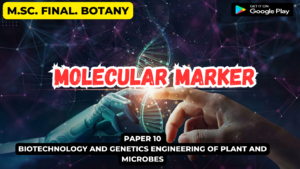![]()
Structural organization of chloroplast
The chloroplast envelope–
The chloroplast envelope serves as a barrier separates the Cytoplasm from the interior region of the chloroplast where photosynthesis takes place. Each chloroplast is bounded by a double membrane system. Each membrane is composed of lipoprotein in nature and each membrane is 40-60A0thick.
The membranes are smooth and differentially permeable. Both the membranes remain apart by a gap of 100-250 A0wide. This space is known as periplastid space that contains Mg ++ dependent ATPase enzyme which take part in the contraction of chloroplast in intense light.
The outer membrane is permeable to a variety of compounds so there is free movement al molecules of cytosol to periplastid space, but the inner membrane acts as a barrier between cytosol and stroma of chloroplasts. It is relatively impermeable to many substance. Such as sugar and other large molecule. The transport of these substances into and out of the chloroplast is performed by transport and shuttle mechanisms that require both transfer of reducing power and ATP which is provided by the chloroplast.

The chloroplast stroma or matrix-
In chloroplast the membranes bound a watery, proteinaceous and transparent substance known as stroma or matrix. The stroma contains different structures like DNA, RNA Ribosomes and about 50% soluble proteins. In addition to these starch grains which store carbohydrates and Lipid called plastoglobuli(osmiophilic droplets) which increase in number during inactive stage of chloroplast and increase in number when new thylakoids are synthesized are also present in the stroma. Biochemical analysis has revealed that besides above components phytoferetin granules and all the enzymes required for carrying out the dark reactions of photosynthesis are also present in stroma. It also contains the factors involved in nucleic acids and protein synthesis. The phytoferetin granules contain harmless iron-protein complex.
In the chloroplast of algae the stroma contain pyrenoids. The major component of pyrenoids granules is ribulose biphosphate carboxylase enzyme which fix carbon dioxide.
In higher plants the enzyme ribulose biphosphate carboxylase is present in special structures called as stroma centers.
The unit structures of chloroplast, i.e. grana and intergrana are also embedded in the stroma
Grana fretwork system Lamellar system–
According to the Electron microscope study of chloroplast – a micrograph of chloroplast show that in the stroma of chloroplast chlorophyll are embedded in the grana(lamellae), these structure are made up of double membranes and in the light reaction of photosynthesis is take place.
The size of grana ranges between 0.3µ-1.7µ and there number in single chloroplast varies from 40-60. In the stroma at various places grana are stacked one above the other forminggranum. The grana lamellae are called as Thylakoid.
The number of thylakoid per granum varies in different species of plant. Only one thylakoid is observed in in red algae, whereas thylakoid number is two in Chrysophyta. In the case of algae and higher plants the number of ranges between three to many.
The grana are interconnected to each other y stroma lamellae called frets (Inter granum). The thylakoid spaces of different grana a communicated via fret work system.
Each granum contains aprox. 50 or more thylakoids. The thylakoid remain contact with stroma through their outer surface. The inner surface of each thylakoid bounds an intra -thylakoid space. The thylakoids provide a large membrane area to hold the photosynthetic pigment and enzymes. They contain chlorophyll pigment for photosynthesis. The light reaction of photosynthesis occur inside the thylakoid whereas dark reaction of photosynthesis take place in stroma. That fix carbon dioxide (CO2) to synthesize sugars, starch, protein and fatty acids.
In the thylakoid ATP and reduced co-enzymes are formed which are diffused out in to the stroma where they are utilized as energy source and reductant respectively the fixation of CO2.
To maintain the structure like grana and frets (tubules) chloroplast require the presence of inorganic salts. If these inorganic salts are replaced by organic buffer the granum open in to membranous system, whereas replacement of organic buffer by inorganic salts reforms the grana and frets. The membrane of grana lamellae contains protein and lipid layers in between these two chlorophyll layer is present.






